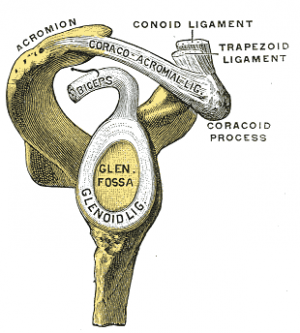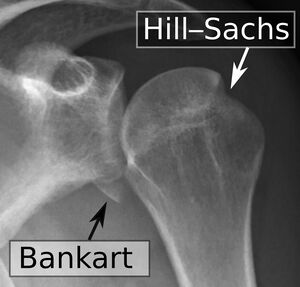Glenoid Labrum: Difference between revisions
No edit summary |
(grammar correction, reference added, citation correction) |
||
| Line 6: | Line 6: | ||
== Introduction == | == Introduction == | ||
[[File:AC ligs.png|thumb|Glenoid Labrum (marked lig.)]] | [[File:AC ligs.png|thumb|Glenoid Labrum (marked lig.)]] | ||
The glenoid labrum is a fibrocartilaginous complex that attaches as a rim to the articular [[cartilage]] of the glenoid fossa. Its role is to | The glenoid labrum is a fibrocartilaginous complex that attaches as a rim to the articular [[cartilage]] of the glenoid fossa. Its role is to deepen and increase the surface area of the glenoid (acting as a static stabiliser of the [[Glenohumeral Joint|glenohumeral joint]]); resist anterior and posterior movement and assist with blocking [[Shoulder Dislocation|shoulder dislocation]] and [[Shoulder Subluxation|subluxation]] at the maximal ranges of motion.<ref name=":0">Radiopedia [https://radiopaedia.org/articles/glenoid-labrum Glenoid Labrum] Available:https://radiopaedia.org/articles/glenoid-labrum (accessed 10.1.2023)</ref> | ||
The labrum is frequently involved in shoulder pathology | The labrum is frequently involved in shoulder pathology by acute trauma (e.g. shoulder dislocation) or more commonly by repeated microtrauma, e.g. shoulder subluxation.<ref name=":1">Clavert P. [https://www.sciencedirect.com/science/article/pii/S1877056814003259 Glenoid labrum pathology.] Orthopaedics & Traumatology: Surgery & Research. 2015 Feb 1;101(1):S19-24.Available:http://www.sciencedirect.com/science/article/pii/S1877056814003259 (accessed 10.1.2023)</ref> | ||
== Structure == | == Structure == | ||
Glenoid labrum basics: | Glenoid labrum basics<ref name=":0" />: | ||
* Made of fibrocartilage, 3 mm thick and 4 mm wide (highly variable). | * Made of fibrocartilage, 3 mm thick and 4 mm wide (highly variable). | ||
* | * The labrum is most commonly triangular or round on cross-section. | ||
* Inferior to the equatorial pole of the glenoid, the labrum gradually becomes rounder and smaller in contrast to superiorly , | * Inferior to the equatorial pole of the glenoid, the labrum gradually becomes rounder and smaller in contrast to superiorly , where it is more triangular in shape and larger. | ||
== Attachments == | == Attachments == | ||
* Superiorly: tendon of the long head of [[Biceps Brachii|biceps brachii]] | * Superiorly: tendon of the long head of [[Biceps Brachii|biceps brachii]]<ref name=":0" /> | ||
* Anteriorly: superior glenohumeral ligament; middle glenohumeral ligament (variably) | * Anteriorly: superior glenohumeral ligament; middle glenohumeral ligament (variably)<ref name=":0" /> | ||
* Inferiorly: inferior glenohumeral ligament | * Inferiorly: inferior glenohumeral ligament consisting of an anterior band, axillary pouch, and a posterior band<ref name=":0" /> | ||
== Clinical Presentation == | == Clinical Presentation == | ||
Patients with tears of the glenoid labrum present with an extensive range of non-specific symptoms including: | Patients with tears of the glenoid labrum present with an extensive range of non-specific symptoms including<ref>Sheikh, Y. (2021) ''Glenoid Labral tear: Radiology reference article'', ''Radiopaedia Blog RSS''. Available at: https://radiopaedia.org/articles/glenoid-labral-tear?lang=us (Accessed: 26 July 2023).</ref>: | ||
* Discomfort/pain, unable to pinpoint. | * Discomfort/pain, unable to pinpoint. | ||
* Joint weakness and instability | * Joint weakness and/or instability | ||
* Clicking | * Clicking | ||
== Anatomic Variants == | == Anatomic Variants == | ||
* Inconsistent cross-sectional shape: blunted, cleaved, notched or flat. | * Inconsistent cross-sectional shape: blunted, cleaved, notched or flat.<ref name=":0" /> | ||
* Medialised posterior labrum | * Medialised posterior labrum<ref name=":0" /> | ||
* Anterior capsulolabral insertion variance<ref name=":0" /> | * Anterior capsulolabral insertion variance<ref name=":0" /> | ||
== Biomechanics == | == Biomechanics == | ||
The labrum | The labrum's most important functions include<ref name=":1" />: | ||
# | # Increasing the contact area between [[Humerus|humeral]] head and [[scapula]]. | ||
# | # Helping in the provision of the “viscoelastic piston” effect. | ||
# | # Providing insertion for stabilising structures, as a fibrous “crossroad”, with the labrum and [[Shoulder|ligaments]] working in synergy, each structure contributing to the varying with the position of the limb. | ||
== Accuracy of Assessment == | == Accuracy of Assessment == | ||
Revision as of 14:27, 26 July 2023
Original Editor - Priyanka Chugh
Top Contributors - Priyanka Chugh, Kim Jackson, Lucinda hampton, Naomi O'Reilly, Wendy Snyders, 127.0.0.1 and Wanda van Niekerk
Introduction[edit | edit source]
The glenoid labrum is a fibrocartilaginous complex that attaches as a rim to the articular cartilage of the glenoid fossa. Its role is to deepen and increase the surface area of the glenoid (acting as a static stabiliser of the glenohumeral joint); resist anterior and posterior movement and assist with blocking shoulder dislocation and subluxation at the maximal ranges of motion.[1]
The labrum is frequently involved in shoulder pathology by acute trauma (e.g. shoulder dislocation) or more commonly by repeated microtrauma, e.g. shoulder subluxation.[2]
Structure[edit | edit source]
Glenoid labrum basics[1]:
- Made of fibrocartilage, 3 mm thick and 4 mm wide (highly variable).
- The labrum is most commonly triangular or round on cross-section.
- Inferior to the equatorial pole of the glenoid, the labrum gradually becomes rounder and smaller in contrast to superiorly , where it is more triangular in shape and larger.
Attachments[edit | edit source]
- Superiorly: tendon of the long head of biceps brachii[1]
- Anteriorly: superior glenohumeral ligament; middle glenohumeral ligament (variably)[1]
- Inferiorly: inferior glenohumeral ligament consisting of an anterior band, axillary pouch, and a posterior band[1]
Clinical Presentation[edit | edit source]
Patients with tears of the glenoid labrum present with an extensive range of non-specific symptoms including[3]:
- Discomfort/pain, unable to pinpoint.
- Joint weakness and/or instability
- Clicking
Anatomic Variants[edit | edit source]
- Inconsistent cross-sectional shape: blunted, cleaved, notched or flat.[1]
- Medialised posterior labrum[1]
- Anterior capsulolabral insertion variance[1]
Biomechanics[edit | edit source]
The labrum's most important functions include[2]:
- Increasing the contact area between humeral head and scapula.
- Helping in the provision of the “viscoelastic piston” effect.
- Providing insertion for stabilising structures, as a fibrous “crossroad”, with the labrum and ligaments working in synergy, each structure contributing to the varying with the position of the limb.
Accuracy of Assessment[edit | edit source]
The ability to predict the presence of a glenoid labral tear by physical examination was compared with that of magnetic resonance imaging (conventional and arthro gram) and confirmed with arthroscopy. Main points of study:
- 37 men and 17 women (average age, 34 years) in the study group, 64% were throwing athletes and 61% recalled specific traumatic events.
- Clinical assessment included history with specific attention to pain with overhead activities, clicking, and instances of shoulder instability.
- Physical examination included the apprehension, relocation, load and shift, inferior sulcus sign, and crank tests.
- Shoulder arthroscopy confirmed labral tears in 41 patients (76%).
- Magnetic resonance imaging produced a sensitivity of 59% and a specificity of 85%.
- Physical examination yielded a sensitivity of 90% and a specificity of 85%.
Conclusion: Physical examination is more accurate in predicting glenoid labral tears than magnetic resonance imaging. In this era of cost containment, completing the diagnostic workup in the clinic without expensive ancillary studies allows the patient's care to proceed in the most timely and economic fashion.[4]
Location of Injuries[edit | edit source]
Labral injuries are named according to localisation
- Superior labrum: SLAP lesion
- Anteroinferior labrum: Bankart lesion; Perthes lesion; Glenolabral articular disruption lesion (GLAD); Anterior labroligamentous periosteal sleeve avulsion lesion (ALPSA)
- Posteroinferior labrum: Reverse Bankart lesion; Posterior GLAD; Posterior labrocapsular periosteal sleeve avulsion lesion (POLPSA); Kim lesion (superficial tears between the posterior glenoid labrum and glenoid articular cartilage without labral detachment)
- Circumferential labral lesion
Treatment and prognosis[edit | edit source]
No general rules exist for management of labral lesions are resected and others fixed. Labral repair or resection can be performed, possibly with capsuloplasty to address joint instability. The cause (which is usually shoulder instability), however, needs to be assessed and treated.[1] [2] See Shoulder Instability
References[edit | edit source]
- ↑ 1.0 1.1 1.2 1.3 1.4 1.5 1.6 1.7 1.8 Radiopedia Glenoid Labrum Available:https://radiopaedia.org/articles/glenoid-labrum (accessed 10.1.2023)
- ↑ 2.0 2.1 2.2 Clavert P. Glenoid labrum pathology. Orthopaedics & Traumatology: Surgery & Research. 2015 Feb 1;101(1):S19-24.Available:http://www.sciencedirect.com/science/article/pii/S1877056814003259 (accessed 10.1.2023)
- ↑ Sheikh, Y. (2021) Glenoid Labral tear: Radiology reference article, Radiopaedia Blog RSS. Available at: https://radiopaedia.org/articles/glenoid-labral-tear?lang=us (Accessed: 26 July 2023).
- ↑ Liu SH, Henry MH, Nuccion S, Shapiro MS, Dorey F. Diagnosis of glenoid labral tears: a comparison between magnetic resonance imaging and clinical examinations. The American journal of sports medicine. 1996 Mar;24(2):149-54.Available:http://journals.sagepub.com/doi/abs/10.1177/036354659602400205 (accessed 10.1.2023)








